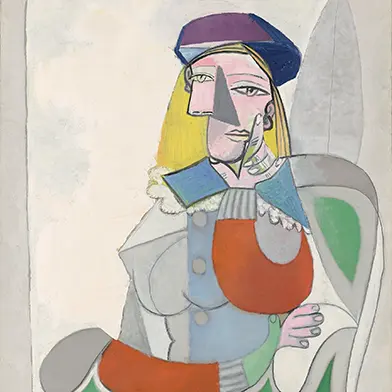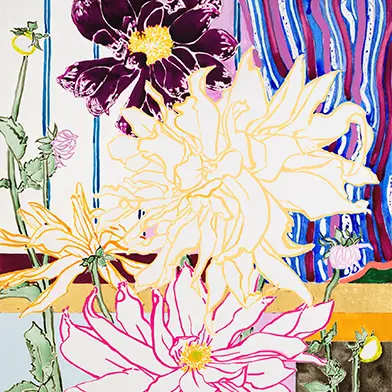Amongst the best known painters of her generation, Bartlett realised a prodigious body of work that defied categorisation, subscribing variously to contemporary art movements including Minimalism, Conceptualism and Neo-Expressionism, although never at the expense of an artistic personality uniquely her own. Unfailingly innovative, in 1968 she began painting on a series of one-foot-square steel plates, coated with white baked enamel and silkscreened with a quarter-inch grid, this newly invented medium inspired by New York City subway signs. The resulting combinations allowed for compositions that were at once intimate and monumental, representational and abstract, and which brought together system-based aesthetics with a range of figurative painting styles. Bartlett was responsible for reinvigorating the practice of painting at a time when many had declared it obsolete, bringing a sense of emotion and subjectivity to programmatic strategy.
From the 1970s onwards the archetypal image of the house was a fundamental symbol in Bartlett’s visual arsenal.
A key feature of her 47-metre-long magnum opus Rhapsody – debuted at Paula Cooper Gallery in 1976 and now in the collection of the Museum of Modern Art, New York – the house presented a thematic odyssey that she would continue to explore for the next 45 years. Comprised of 987 plates, Rhapsody brought Bartlett to widespread acclaim and became the catalyst for a level of attention that was rare for female painters of her generation. It introduced the house as one of four simple figurative motifs that could be distilled to an essential form, alongside the tree, the mountain and the ocean. Although Bartlett would go on to explore each in depth, it was the house that caught her imagination first. By deconstructing the rudimentary triangle-atop-square form, she systematically dismantled any fixed definition of home, at the same time using it as a conduit to explore different emotional states. Bartlett’s first ‘house’ works made in 1977 were titled after the addresses of her inner circle. Commonly referred to as the Addresses, this body of work acts as portraits of the artist’s friends and family.
Aside from its personal significance to Bartlett, the house as an emblem carries a universality, evoking notions of home, stability and domesticity. In common with this idea, the methodical nature of Bartlett’s practice conjures associations with labour-intensive ‘women’s work’, something that took on an increased significance in the 1970s as feminist art practice gained traction. Made some decades later, works such as Houses: Thin Lines (1998) encapsulate the meticulous nature of Bartlett’s work: here a thicket of cross-hatched lines applied with precision to her idiosyncratic steel plates dissolves in front of the viewer’s eyes to reveal a row of houses along a winding road.
The house remained a mainstay of Bartlett’s practice until the end of her career, as she continued to find fresh ways to invigorate its meaning. Untitled (House) for example, from 2014, is rendered with thick, visible brush strokes of oil paint on canvas, its primary palette a reflection of the earlier House: Yellow Roof Left (1998), which partitions the canvas into irregular quadrants of blue, yellow, red and green – the colours she had originally limited her painting to when she was making paintings with enamel in the 1970s. Meanwhile Seaside Houses (2000) depicts the landscape around her home in Long Island, suggesting an interest in self-portraiture as she reflected on the psychological Addresses of the late 1970s. In works such as 3-D House, Grid (1998-1999) and Untitled (Three Wood Houses) (2002), Bartlett brings the house into relief, bestowing a three dimensionality on her paintings that she explores elsewhere in large-scale installations.
Seen for the first time in London in over 40 years, the works in In the House reveal the depth and innovation of Bartlett’s research-oriented practice, which found enduring meaning in four walls for almost five decades.
Jennifer Bartlett (1941-2022) was born in Long Beach, CA and studied at Mills College, Oakland, CA and the Yale School of Art, New Haven, CT. Her work is featured in the collections of Hirshhorn Museum and Sculpture Garden, Washington, DC; Dallas Museum of Art, TX; Los Angeles County Museum of Art, CA; Metropolitan Museum of Art, New York, NY; Museum of Fine Arts, Houston, TX; Museum of Modern Art, New York, NY; Philadelphia Museum of Art, PA; San Francisco Museum of Modern Art, CA; Tate, London; Naoshima Museum, Japan; and Whitney Museum of American Art, New York, NY, among many others. The first major museum survey exhibition of Bartlett’s work was organized in 1985 – it travelled from Walker Art Center, Minneapolis, MN to Brooklyn Museum, NY and Carnegie Museum of Art, Pittsburgh, PA. Bartlett’s first institutional solo exhibition in the UK took place at Tate in 1982. In 2006, her early enamelled steel plate paintings were surveyed at the Addison Gallery of American Art, Andover, MA. In 2013 and 2014, a second survey of Bartlett’s work—Jennifer Bartlett: History of the Universe, curated by Klaus Ottmann – travelled to Pennsylvania Academy of the Fine Arts, PA and Parrish Art Museum, Water Mill, NY.
all images © the gallery and the artist(s)


